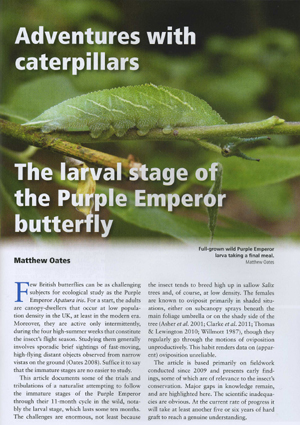 |
British Wildlife magazine Volume 23 number 5 (June 2012), carried a fine article by Matthew Oates entitled "Adventures with Caterpillars - The larval stage of the Purple Emperor butterfly". Mainly based on his observations of a sample of over 250 caterpillars found during the period 2009-2011 the article adds significantly to the earlier bodies of knowledge provided by Ken Willmott and others including Asher, Clarke, Thomas and Lewington and, importantly, it highlights the major gaps in knowledge that still exist.
British Wildlife is a first class publication and well worth the subscription (see www.britishwildlife.com). For the benefit of those who do not take the magazine I have written this précis.
One important conclusion is that the Purple Emperor does prefer the true Goat Willow, but as this is becoming rarer in southern England and is virtually absent in Northamptonshire, other forms of willow namely the S. x reichardtii hybrids that are most like Goat Willow and Rusty Sallow with certain foliage characteristics will also be used. Matthew concluded that the physical aspects of the foliage was more important than the sallow's taxonomic characteristic with the butterfly favouring strongly leaves that during late summer and early autumn are mid-green in colour, have a matt rather than glossy upper surface and are not coarse or thick to the touch. These features are usually associated with trees growing in shade and not coming into leaf too early. Further research is needed on this.
Matthew described the stages of development of the larvae.
The article carries a superb photograph of a first-instar larva in early August eating the egg case on emergence. Matthew went on to describe how this stage lasts for about 10-12 days with the caterpillar taking short intermittent meals from the leaf edges near the tip. Significantly, Matthew identified a 25% loss or disappearance of larvae at this stage for reasons unknown. However these seem to be mirrored in outdoor captive breeding. Heat desiccation is one explanation and another possibility is they can be washed away in heavy rain.
The second-instar lasts for about 25-35 days. The larvae, which now sport an impressive pair of horns, only feed very intermittently and grow slowly. They seldom change leaf and losses in the wild are relatively low.
The third-instar is reached in late August/first half of September and this stage lasts until late April or early May. Most larvae move onto a new leaf. Feeding bouts and growth continue to be slow. During the whole of their lives the larvae spin silk on their leaf and develop a "seat" at the tip end, usually one that curls down and holds rain drops. Another fine photograph illustrated a subtle change in colour from Lincoln-green that takes place as Autumn progresses. However Matthew observed that the colour of the caterpillar often bore no relation to the colour of the leaf. This process was found to take between one and five weeks and in 2009 nearly all surviving larvae (about 70) had changed colour by the end of October.
Matthew made great efforts to track larvae into hibernation, a process that takes place between late October and mid-November. In 2009 36% of the larvae disappeared leading Matthew to conclude that the journey to a suitable spot to hibernate was one of the three most vulnerable periods in the life of the caterpillar. Matthew had studied the larvae in three years when the Autumn weather was mild and dry and he expressed interest in results of a study in a wetter year when larvae may move less. Matthew described in some detail hibernation positions taken up by caterpillars. On average the hibernating caterpillars measure 12 mm. Losses of hibernating larvae are heavy ñ 60% in the first two years of the survey and it seems likely that much of this is due to predation by tits. It seems predation is at a higher rate when larvae are numerous.
Larvae move out of hibernation in early April. At first they position themselves next to the swelling buds where they wait for the leaves to develop. They change from their drab colour into a vernal green and generally start feeding by the end of April. An important factor that Matthew registered was that egg-laying females avoid trees that come into leaf early, especially non-flowering trees. He presumed that such trees develop unsuitable coarse, dark, thick leaves as the season progresses. The larvae change into the fourth instar in early- to mid-May and then feed vigorously in sunshine and on warm evenings. They grow rapidly and become increasingly sun loving. They move about more often wandering several metres before returning to their seat leaf.
The final instar is achieved in late May or even early June. However they are very hard to see even though they are the size of an adult's little finger! It was a great disappointment to Matthew that after he had had ten months of close association with them nearly all full-grown larvae disappeared suddenly and mysteriously. On occasions Matthew made a similar observation to Heslop - namely the swift ascent of full-grown larvae into the crowns of sallow trees. Thus pupae are difficult to find and Matthew only found one wild pupa. He is determined to solve the mystery of whether there is a high mortality rate or whether they pupate off their sallow tree or just really well hidden on it.
Matthew concluded that the Purple Emperor needs sallows growing in quite heavy shade and that the next stage of his ongoing research will clarify appropriate habitat management options.
Matthew has made it clear that the article does not constitute a scientific paper. He also stresses he was only able to cover in the article a small amount of the information gathered . A significant omission was comments on management and more importantly information on effective techniques for expanding breeding requirements the most suitable sallow for Purple Emperors.